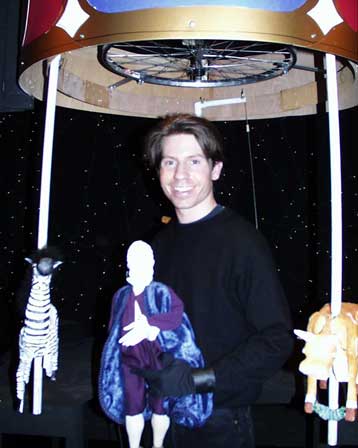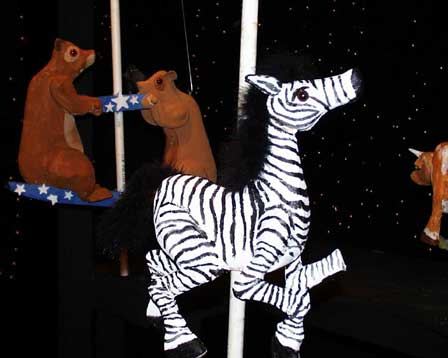
Galileo's Telescope
created by Eric Jacobson
at HERE
New York, NY
December 10, 1999
reviewed by Donald Devet

Galileo's Telescope
created by Eric Jacobson
at HERE
New York, NY
December 10, 1999
reviewed by Donald Devet
Eric Jacobson and Sean McCourt fell in love with the idea of a man falling through space. First they wrote a novella exploring Galileo's adventures. Not satisfied with words on paper, they visualized their ideas in the form of a puppet show. Galileo's Telescope is that realization.
Rather than presenting a finished show, Jacobson has chosen to stage excerpts. Comprising only twenty-five minutes, the vignettes give a good idea of the direction Jacobson wants to take. By testing several scenes in front of an audience, Jacobson hopes to learn what works technically as well as dramaturgically.
Ronald Binion costumed as Sir Isaac Newton opened the program by cautioning the audience against stereotyping famous theorists by their props, i.e. Newton's apple, Galileo's telescope. There is more to these men than meets the eye.
A toy theater's curtain parted to reveal a miniature Galileo who climbed an enormously tall tree whose roots reached to China and whose uppermost boughs ascended into the stars. In his quest to explore the heavens up close, Galileo encountered a chatty squirrel. After a lengthy dialog they fell out of the tree. Leaving the confines of the toy theater, Galileo and the squirrel (represented by a rod and a hand puppet, manipulated Bunraku style) hurled through the vast star studded blackness of space. Galileo believed they were falling toward the center of the universe, Earth. The squirrel had second thoughts.
The planet Jupiter played by actor Ed Woodham, wrapped in a bright orange Hari Krishna robe, was their first encounter. Having awakened from a deep sleep, Jupiter set into motion his many moons represented by a carousel of animals- Zebra, Bears, Cow. Circling Jupiter's shaved head, the animals bobbed and seesawed in time to a galloping calliope tune. The scene was a technological marvel, beautifully executed.
Next, Haley's comet streaked by to offer Galileo and the squirrel a hitch on its tail. And their journey continued.
Also assisted by Sam Hack, Barry Weil, James Wojtal, Kira Bernstein, Tanya C. Khordoc and Anthony W. Costello, Jacobson has envisioned an ambitious odyssey by using the character of Galileo to explore the concept of a self-centered universe versus a universe where humankind is only one of many centers. Galileo is known today as a radical thinker of his time for daring to declare that the Earth revolves around the Sun. Galileo's Telescope attempts to show how Galileo might have come to that startling realization. But can this concept sustain a full length production?
Maybe Jacobson is too in love with the idea of a man falling through space and not with the man himself. As written, Galileo's character vacillates between acting like Don Quixote on one hand and Wimpy on the other. It was difficult to get a handle on what Galileo truly believed . Besides, he is not a character who is easy to empathize with. Galileo as portrayed in history books can be appreciated intellectually. But it will take a great deal of ingenuity to reshape Galileo into someone the audience will care for on an emotional level.
And then there was that squirrel. The squirrel seemed to be a device to give Galileo something to talk to as he fell through space. Unfortunately, the squirrel talked back. It's as if the squirrel had leapt into the wrong story. It (He? She?) belonged in a kiddie show, not a tale for grown-ups. Perhaps intended for comic relief, the squirrel jabbered ad nauseum, adding little comedy, only heaps of static.
Jacobson's future plans for the story have Galileo encountering other planets- Saturn, Venus, Earth, Mars, Mercury and even the Sun itself. This performance was a journey of self-discovery for Jacobson as well as for Galileo, exactly the journey this workshopped version of Galileo's Telescope had hoped to achieve.
 "Eric Jacobson with Galileo" photo by Donald Devet |
 "Europa, one of Jupiter's planets" photo by Donald Devet |
Copyright © 2000 Donald Devet